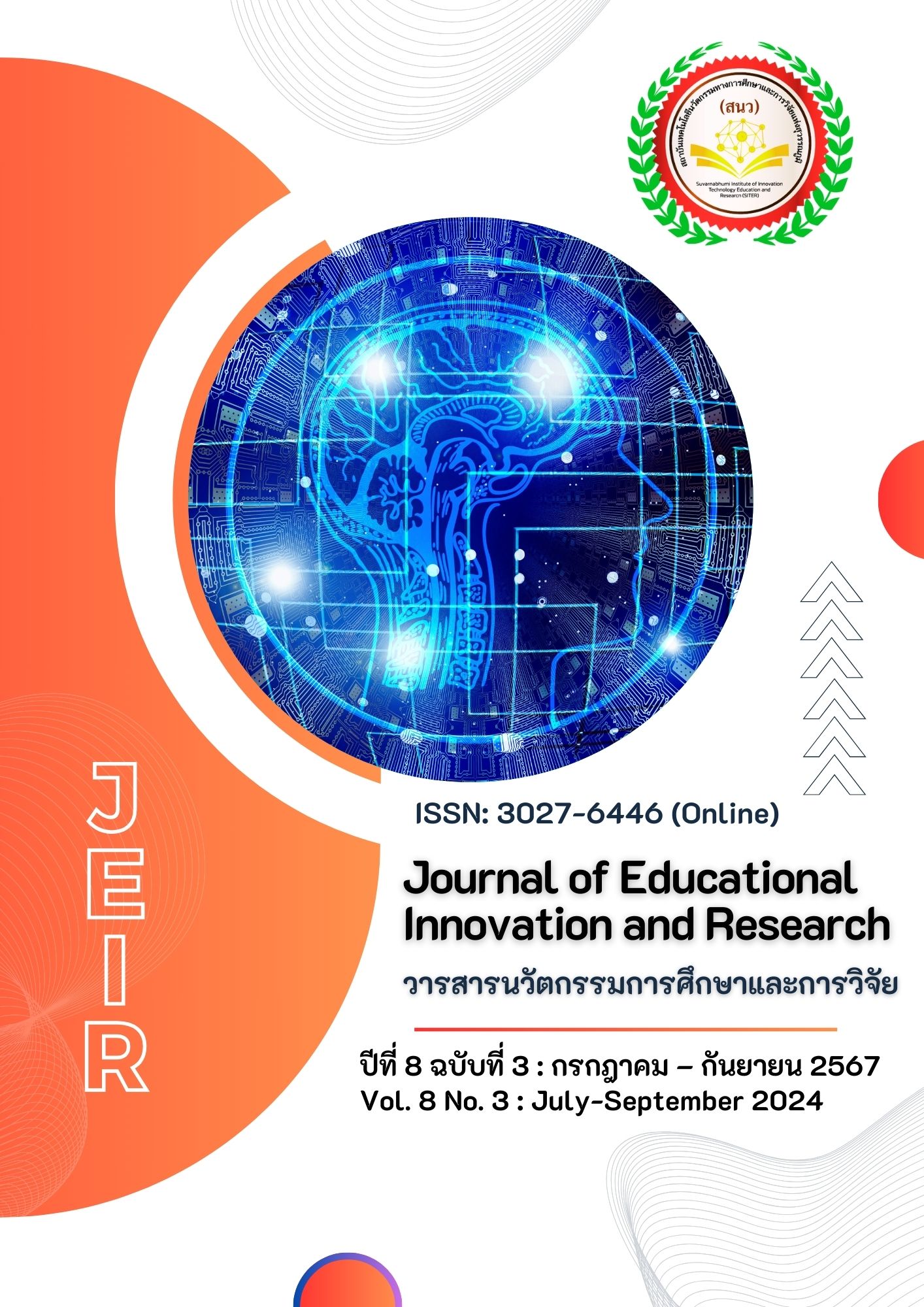การพัฒนารูปแบบการเรียนรู้แบบผสมผสานโดยใช้การเรียนรู้แบบร่วมมือร่วมกับการตอบกลับอัตโนมัติเพื่อส่งเสริมการคิดวิเคราะห์ สำหรับนักศึกษาปริญญาตรี
Main Article Content
บทคัดย่อ
บทความนี้มีวัตถุประสงค์ 1) เพื่อพัฒนารูปแบบการเรียนรู้แบบผสมผสานโดยใช้การเรียนรู้แบบร่วมมือร่วมกับการตอบกลับอัตโนมัติ เพื่อส่งเสริมการคิดวิเคราะห์สำหรับนักศึกษาปริญญาตรี 2) เพื่อประเมินความเหมาะสมของรูปแบบการเรียนรู้แบบผสมผสานโดยใช้การเรียนรู้แบบร่วมมือร่วมกับการตอบกลับอัตโนมัติ เพื่อส่งเสริมการคิดวิเคราะห์สำหรับนักศึกษาปริญญาตรีวิธีดำเนินการวิจัยมี 6 ขั้นตอน ได้แก่ 1) ศึกษาเอกสารและงานวิจัยที่เกี่ยวข้อง 2) สังเคราะห์และร่างกรอบแนวคิดรูปแบบการเรียนการสอน 3) สร้างเครื่องมือเพื่อประเมินรูปแบบการเรียนการสอน 4) กำหนดคุณสมบัติของผู้เชี่ยวชาญโดยการคัดเลือกแบบเจาะจง (Purposive Sampling) จำนวน 10 คน สำหรับอภิปรายกลุ่ม 5) จัดประชุมเพื่ออภิปรายกลุ่มและประเมินรูปแบบการเรียนการสอน 6) สรุปผล วิเคราะห์ข้อมูล และปรับปรุงแก้ไข วิเคราะห์ข้อมูลใช้ค่าเฉลี่ย และส่วนเบี่ยงเบนมาตรฐาน
ผลการวิจัยพบว่า องค์ประกอบของรูปแบบการเรียนการสอนที่พัฒนาขึ้นประกอบด้วย 3 องค์ประกอบ คือ 1) การเตรียมการ 2) กิจกรรมการเรียนการสอน และ 3) การประเมินผล ผลการประเมินความเหมาะสมของรูปแบบการเรียนการสอนที่สังเคราะห์ขึ้น โดยผู้เชี่ยวชาญที่เป็นผู้สอนด้านคอมพิวเตอร์และด้านการศึกษา ทั้งหมดให้การยอมรับรูปแบบการเรียนการสอนที่สังเคราะห์ขึ้น มีความเหมาะสมอยู่ในระดับมากที่สุด (= 4.52, S.D. = 0.58) แสดงให้เห็นว่ารูปแบบการเรียนการสอนที่สังเคราะห์ขึ้นสามารถนำไปใช้ในการจัดการเรียนการสอนได้จริง
Article Details

อนุญาตภายใต้เงื่อนไข Creative Commons Attribution-NonCommercial-NoDerivatives 4.0 International License.
เอกสารอ้างอิง
Areesophonpichet, S. (2014). Instructional Strategy for Develop of Analytical Thinking Skill: The Concept Mapping. Education Studies Journal Chulalongkorn University, 42(3), 194-210.
Bersin, J. (2004). The Blended Learning Book, Best Practices, Proven Methodologies, and Lessons Learned. John Wiley & Son, Inc. San Francisco, CA.
Bloom, B. S. (1976). Human characteristic and school learning. New York: McGraw–Hill.
Dewey, J. (1933). How we think: A restatement of the relation of reflective thinking to the educative process. Boston DC: Heath and Company.
Ennis, R.H. (1985). A logical Basic for Measuring Critical Thinking Skill. Educational Leadership, 43, 45-48.
Good, C. V. (1973). Dictionary of education. New York: McGraw-Hull Book Company.
Graham, C., Woodfild, W. & Harrison, J. (2012). A framework for institutional adoption and implementation of blended learning in higher education. In Internet and Higher Education.
Jannim, S., Muankid, P. and Chianchana, C. (2019). The Development of Instructional Model to Enhanced Analytical Thinking skills for Higher Education Student of Industrial Technology. Technical Education Journal: King Mongkut’s University of Technology North Bangkok, 10(3), 79-87.
Laowreandee, W. (2017). Active Learning instructional stratrgies for thinking development and educational improvement of the 21st century. Nakhon Pathom: Phetkasem Printing Group.
Marzano, R.J. (2001). Design a New Taxonomy of Education Objective. Thousand Oks, California: Corwin Press, Inc..
McSporran, M. & King, C. (2005). Blended Is Better: Choosing Education Delivery Method. Retrieved June 14, 2009, from: http//hyperdisc.unitec.ac.nz/research/KingMcsporranEdmedia2005.pdf
Moonkham, S. (2004). Analytical Thinking Strateg. Bangkok: Parbpim.
Nakphong, P. (2019). The Development of Analytical Thinking Skill of Seventh Grade Students By Using Problem Based Learning and Stad Technique [Master’s Thesis, Silpakorn University].
Poonsawad, A. (2021). Development of Problem-based Interactive Digital Storytelling Learning Model under Gamification Environment Promoting Students’ Problem-Solving Skills [Doctoral dissertation, King Mongkut’s University of Technology North Bangkok].
Praoaut, P. (2010). The development of learning outcomes on measurement of third grade students taught with STAD technique and child Thai folk play activities [Master’s Thesis, Silpakorn University].
Rothrauff, L. (2011). Blended learning; What is it and why try it? Retrieved May 25, 2010, from: http://ets.berkeley.edu/article/blended-learning-what-it-and-why-try-it
Slavin, R. E. (1991). Student team learning: a practical guide to cooperative learning. 3rd Ed. Washington, DC: National Education Association of the United States.
Susoarat, P. (2013). Thinking Development. Bangkok: 9119 Technic Printing.
Tiantong, M. (2013). Innovation: computer-based learning and teaching (Edition 1). Bangkok: Danex Intercorporation Company Limited.
Titayanuvat, B. (2010). The development of hearing impaired students' learning outcomesin addition word problems of the sixth grade students' taught by cooperative learning together with kwdl technique [Master’s Thesis, Silpakorn University].
Wiangwalai, S. (2013). Learning management. Bangkok: Odenstore.
Yingnok, P. (2021). The Study of Learning Achievement and Analytical Thinking By Using The 5 Steps Learning Process With The Cooperrative Learning Method Stad Technique on Geological Resources of 10th Grade Students [Master’s Thesis, Burapha University].


